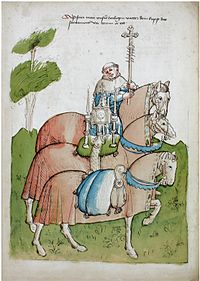
Baldassarre Cossa was Pisan antipope John XXIII (1410–1415) during the Western Schism. The Catholic Church regards him as an antipope, as he opposed Pope Gregory XII whom the Catholic Church recognizes as the rightful successor of Saint Peter. He was also an opponent of Antipope Benedict XIII, who was recognized by the French clergy and monarchy as the legitimate Pontiff.

The Council of Constance was an ecumenical council of the Catholic Church that was held from 1414 to 1418 in the Bishopric of Constance (Konstanz) in present-day Germany. The council ended the Western Schism by deposing or accepting the resignation of the remaining papal claimants and by electing Pope Martin V. It was the last papal election to take place outside of Italy.

Pope Gregory XII, born Angelo Corraro, Corario, or Correr, was head of the Catholic Church from 30 November 1406 to 4 July 1415. Reigning during the Western Schism, he was opposed by the Avignon claimant Benedict XIII and the Pisan claimants Alexander V and John XXIII. Gregory XII wanted to unify the Church and voluntarily resigned in 1415 to end the schism.

The Abbey of Saint Gall is a dissolved abbey (747–1805) in a Catholic religious complex in the city of St. Gallen in Switzerland. The Carolingian-era monastery existed from 719, founded by Saint Othmar on the spot where Saint Gall had erected his hermitage. It became an independent principality between 9th and 13th centuries, and was for many centuries one of the chief Benedictine abbeys in Europe. The library of the Abbey is one of the oldest monastic libraries in the world.

The Avignon Papacy was the period from 1309 to 1376 during which seven successive popes resided in Avignon rather than in Rome. The situation arose from the conflict between the papacy and the French crown, culminating in the death of Pope Boniface VIII after his arrest and maltreatment by Philip IV of France. Following the subsequent death of Pope Benedict XI, Philip forced a deadlocked conclave to elect the French Clement V as pope in 1305. Clement refused to move to Rome, and in 1309 he moved his court to the papal enclave at Avignon, where it remained for the next 67 years. This absence from Rome is sometimes referred to as the "Babylonian captivity of the Papacy".
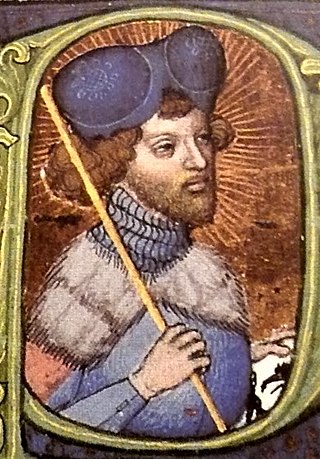
Wenceslaus IV, also known as Wenceslaus of Luxembourg, was King of Bohemia from 1378 until his death and King of Germany from 1376 until he was deposed in 1400. As he belonged to the House of Luxembourg, he was also Duke of Luxembourg from 1383 to 1388.
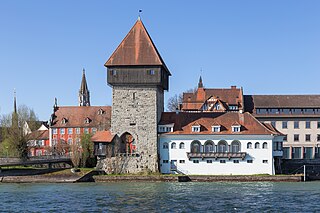
Konstanz, also known as Constance in English, is a university city with approximately 83,000 inhabitants located at the western end of Lake Constance in the south of Germany. The city houses the University of Konstanz and was the residence of the Roman Catholic Diocese of Konstanz for more than 1,200 years.

The Western Schism, also known as the Papal Schism, the Great Occidental Schism, or the Schism of 1378, was a split within the Catholic Church lasting from 1378 to 1417 in which bishops residing in Rome and Avignon both claimed to be the true pope, and were joined by a third line of Pisan claimants in 1409. The schism was driven by personalities and political allegiances, with the Avignon Papacy being closely associated with the French monarchy.

Pierre d'Ailly was a French theologian, astrologer and cardinal of the Roman Catholic Church.
Bernold of Constance was a chronicler and writer of tracts, and a defender of the Church reforms of Pope Gregory VII.

Petershausen Abbey was a Benedictine imperial abbey at Petershausen, now a district of Konstanz in Baden-Württemberg, Germany.
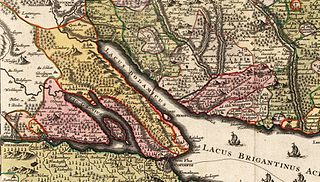
The Prince-Bishopric of Constance was a small ecclesiastical principality of the Holy Roman Empire from the mid-12th century until its secularisation in 1802–1803. In his dual capacity as prince and as bishop, the prince-bishop also administered the Diocese of Konstanz, which existed from about 585 until its dissolution in 1821, and whose territory extended over an area much larger than the principality. It belonged to the ecclesiastical province of Mainz since 780/782.

Mikołaj Trąba, of Trąby coat of arms, was a Polish Roman Catholic priest, Royal Notary from 1390, Deputy Chancellor of the Crown 1403–12, bishop of Halicz 1410–12, archbishop of Gniezno from 1412, and first primate of Poland 1417–22.

Konstanz Minster or Konstanz Cathedral is a historical building in Konstanz, southern Germany, the proto-cathedral of the former Roman Catholic diocese of Konstanz.

Conrad of Constance was a German bishop and saint.

Gebhard of Constance was a bishop of Constance from 979 until 995. He founded the Benedictine abbey of Petershausen in 983. Regarded as a Christian saint, his feast day is 27 August.
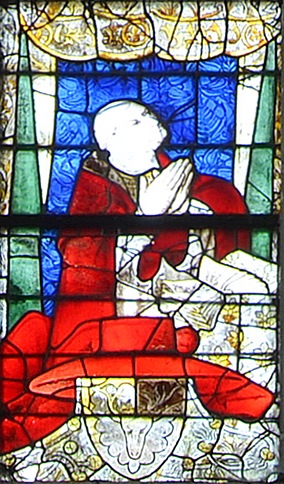
Guillaume Fillastre, sometimes called the Elder, was a French cardinal, canonist, humanist, and geographer.
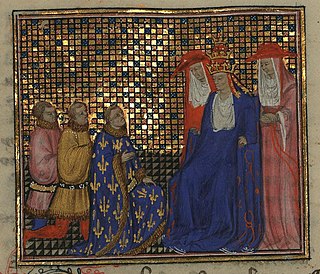
Robert of Geneva was elected to the papacy as Clement VII by the cardinals who opposed Pope Urban VI and was the first antipope residing in Avignon, France. His election led to the Western Schism.

The Dominican Island or Constance Island is an island in Lake Constance immediately east of the city of Constance. With an area of 1.8 hectares, it is one of the smaller islands in the lake. The island is separated from the city center by a six-metre-wide (20 ft) channel, and connected to it by a bridge. The island is dominated by the Steigenberger hotel, which is housed in the former Dominican convent.
Constance de Rabastens (13??–1386) was one of the female visionaries who concerned herself with politics in the late fourteenth century. Many visionaries emerged in the late fourteenth century that predicted the future of the Church. Visionaries often claimed that their visions came from God and that the Church should listen to what is being told. Unlike Catherine of Siena and Marie Robine, other visionaries of the Great Schism, Constance was denied any official recognition and Constance at one point had to extract herself from an inquisitorial interrogation only with great difficulty. During the Great Schism there were multiple popes, the pope and the antipope, and Constance's denial of any official recognition was because she endorsed the "wrong" pope through her divinely inspired prophetic pronouncements. Little is known about Constance's life as her confessor, Raymond de Sabanac, decided not to write about her life and decided to only write about her visions. Although there are not much known about Constance's life, there are documents about her visions and the letters she wrote to the inquisitor of Toulouse that are preserved in a Catalan translation in Bibliothèque nationale de France. Most of Constance's visions were put together by her confessor, Raymond de Sabanac, but some series of visions were transmitted to Raymond by Constance's son.
